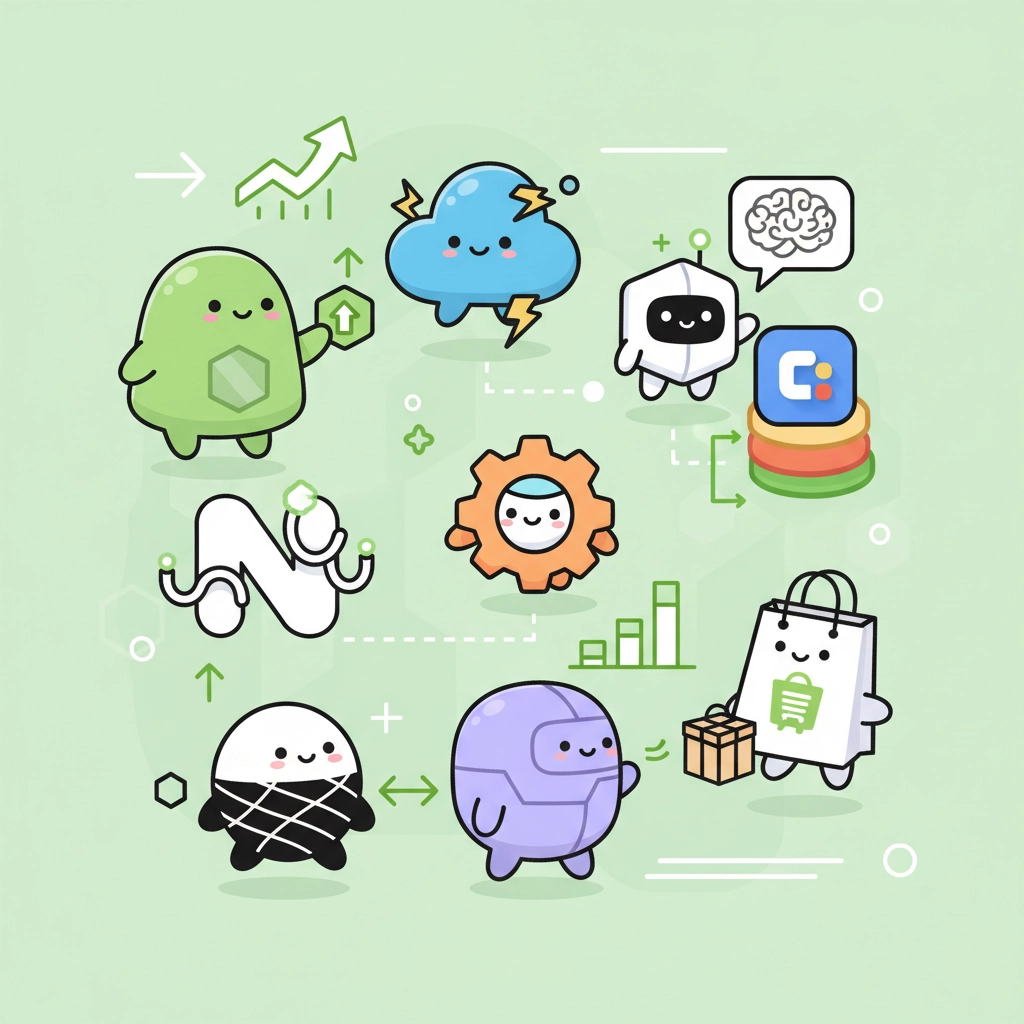I’ve been working with AI tools in E-Commerce for years now, and I’ve seen everything from game-changing wins to spectacular failures. After testing dozens of platforms and watching countless implementations, I’ve landed on a core toolkit that actually delivers results for small and medium E-Commerce teams.
Before I dive in, let me be clear about something – this isn’t about chasing the latest AI trend or slapping “artificial intelligence” onto everything you do. I wrote about this problem recently when discussing Microsoft’s Co-Pilot rollout, where businesses rushed to implement AI without thinking through the workflow or training their teams properly. The result? More confusion, inconsistent processes, and frustrated staff.
The difference between AI that works and AI that doesn’t comes down to one thing – choosing tools that fit your actual needs and connecting them thoughtfully. Here are the tools I rely on, with real examples of how they help E-Commerce teams punch above their weight.
Notion – My Operations Command Centre
Let me start with my absolute favourite – Notion has become the backbone of how I run E-Commerce operations. If you haven’t used it before, think of Notion like digital Lego blocks for your business. You can build databases, documents, task lists, calendars, and knowledge bases that all connect and talk to each other.
What makes Notion special is how flexible it is. I’ve built everything from client onboarding systems to inventory tracking dashboards, all customized to match exactly how each business works. The setup takes effort – I won’t lie about that – but once you have it dialed in, it becomes whatever your operation needs it to be.
The AI integration is where things get really powerful. Notion’s AI can summarize messy email chains into clean action items, generate meeting notes from scattered thoughts, and even draft SOPs based on your existing processes. I recently helped a client turn three weeks of scattered product launch emails into a structured project timeline in about ten minutes using Notion’s AI.
Here’s a real example – I use Notion to centralize all client intelligence. When someone mentions a competitor, sends a supplier update, or shares market feedback, it all goes into the same workspace. The AI helps me spot patterns and pull out key insights that would take hours to find manually. It’s like having an always-on business analyst who never gets tired.
The scheduling and project management features are equally solid. I can see what every team member is working on, track project milestones, and keep everyone aligned – even when we’re spread across different time zones. For E-Commerce teams juggling product launches, seasonal campaigns, and daily operations, having everything in one connected system is a lifesaver.
Zapier and Make – The Invisible Workforce
Workflow automation is where most E-Commerce teams can save massive amounts of time, and Zapier and Make (formerly Integromat) are my go-to tools for connecting different apps together.
Both platforms now have built-in AI agents that can handle much more complex workflows than simple “if this, then that” automations. These AI agents can make decisions, process text, and even handle multi-step logic without you needing to code anything.
For teams that are more technically inclined, I’d also recommend checking out N8N. It’s an open-source automation platform that’s harder to use but can save money and offers more power for custom integrations. The learning curve is steeper, but if you’ve got someone on your team who likes to tinker, N8N can do things the other platforms can’t.
Here’s how I use automation in practice – I set up a workflow that automatically syncs new Shopify customers to a segmented Google Sheet, triggers personalized abandoned cart emails based on the products they viewed, and routes high-value orders to a priority fulfillment queue. All of this happens without anyone touching it.
Another favourite automation – getting a daily summary of all customer service interactions, highlighting any possible trends or recurring issues. This not only keeps teams ahead of potential problems, but lets you spot opportunities to improve the customer experience—before tickets pile up or new patterns go unnoticed.
Google Workspace and Gemini – The Smart Assistant
Google’s Gemini AI integration across Workspace has been a pleasant surprise. What started as basic autocomplete has evolved into genuinely helpful content generation and data processing.
I use Gemini most for product descriptions and marketing copy, especially when I want to test multiple versions. Feed it some bullet points about a new product, and it’ll generate multiple variations of descriptions, each with a different tone or focus. It’s not perfect – you still need to edit and refine – but it cuts the initial writing time by 70%.
It’s also one of my favourite research tools. I like the real-time web results that it can pull in. And in my experience, it has been WAY faster that ChatGPT.
The real power shows up in Gmail and Google Sheets. Gemini can automatically categorize customer emails, draft responses to common questions, and even pull key information from long email threads into structured summaries. For E-Commerce teams dealing with supplier communications, customer service, and partnership discussions, this kind of smart inbox management is incredibly valuable.
I recently used Gemini to process three months of customer feedback emails, pulling out common themes and pain points that informed our next product roadmap. What would have taken days of manual reading and note-taking happened in about an hour.
ChatGPT – The Creative Problem Solver
ChatGPT has become my default brainstorming partner and research assistant. While everyone talks about using it for content creation, I find its real strength is in problem-solving and strategic thinking.
When I’m stuck on a tricky customer service situation, I’ll describe the problem to ChatGPT and ask for multiple approaches. It rarely gives me the perfect answer, but it consistently offers perspectives I hadn’t considered. Same thing with product positioning, campaign ideas, or operational challenges.
For policy writing, ChatGPT is phenomenal. I’ve used it to draft return policies, shipping terms, and customer service scripts that would normally take hours of back-and-forth with legal teams. The AI generates a solid first draft, then I refine it to match the brand voice and business requirements.
One client was launching in a new market and needed to understand local E-Commerce regulations. ChatGPT helped research the key compliance requirements and competitive landscape, then organized everything into a clear briefing document. It saved weeks of research time and gave us a solid foundation for the expansion strategy.
NotebookLM – The Document Detective
NotebookLM is Google’s research-focused AI tool, and it’s incredibly useful for processing large amounts of information quickly. Think of it as having a research assistant who can read dozens of documents and pull out exactly what you need.
It’s also excellent for learning new topics fast. Drop in a stack of documents on any subject, and it will distill the key concepts into simple, step-by-step summaries you can follow—even if you’re brand new to the space.
I use NotebookLM most for competitive analysis and supplier research. Upload a bunch of competitor websites, product catalogs, and marketing materials, then ask specific questions about positioning, pricing strategies, or feature comparisons. It’ll analyze everything and give you clear, source-backed answers.
Recently, I helped a client evaluate five potential fulfillment partners by feeding all their contracts and service descriptions into NotebookLM. Instead of spending days reading through terms and conditions, we got a clear comparison of pricing, service levels, and contract terms in about 30 minutes.
The tool is also excellent for digesting market research reports, industry studies, and customer feedback. It can spot trends and patterns that are easy to miss when you’re reading individual documents, and it always shows you exactly where each insight came from.
It can even generate an audio podcast from your research notes or concepts—so you can listen and learn anywhere, or vet your own ideas by hearing them presented aloud.
Marblism and Sintra – The Digital Employees
This category is newer but promising – platforms that offer specialized AI “employees” for specific business functions. I’ve been testing both Marblism and Sintra, and while they’re both still evolving, they’re headed in the right direction.
These aren’t just chatbots or simple automation tools. They’re more like having dedicated team members who handle specific types of work consistently and reliably.
For mail management, these tools can sort incoming emails by priority, draft initial responses to common questions, and flag anything that needs immediate attention.
The call summarization feature has been particularly useful for client work. Instead of taking detailed notes during every strategy call, the AI listens in and produces clean summaries with action items and key decisions. Everyone on the team gets the same information, and nothing falls through the cracks.
For customer service automation, these platforms shine when you have a small team but need to provide consistent, professional support. The AI can handle order status inquiries, return requests, and basic product questions – freeing up human team members for complex issues that need personal attention.
Content production is another strong use case. Feed these tools your brand guidelines and product information, and they can generate blog posts, product descriptions, and social media content that matches your voice. It’s not perfect, but it gives you a solid starting point that used to take hours to create from scratch.
My recommendation? Test both Marblism and Sintra to see which fits your workflow better. They each have different strengths, and the space is moving quickly.
Shopify – The Platform That Gets Smarter
Shopify has been quietly building AI features into their platform, and some of them are genuinely useful for day-to-day operations. Shopify Magic, their AI-powered content tool, can generate product descriptions, blog posts, and even marketing copy directly in your admin panel.
I’ve used Shopify Magic to help clients launch large product catalogs quickly. Instead of writing unique descriptions for hundreds of SKUs, we’d feed the AI basic product information and let it generate first drafts. With some editing and brand voice refinement, we could launch complete collections in days instead of weeks.
The built-in fraud detection has also gotten much smarter. Shopify’s AI can spot suspicious ordering patterns, flag potentially fraudulent transactions, and even prevent chargebacks before they happen. For E-Commerce businesses dealing with high-risk products or international sales, this kind of automated protection is invaluable.
Product recommendations powered by AI help drive upsells and cross-sells without feeling pushy. The system learns from customer behaviour and suggests relevant products at the right moments.
The customer service chat features are basic but functional. For businesses just starting out, having AI handle simple questions like store hours, shipping policies, and return procedures can provide 24/7 support without hiring additional staff.
Building Your Connected AI Ecosystem
The real power comes from connecting these tools together instead of using them in isolation. Here’s how a typical workflow might look:
A new order comes into Shopify, which triggers a Zapier automation that updates your Notion customer database, sends order details to your fulfillment team, and schedules a follow-up review request. When the customer responds, ChatGPT helps draft a personalized thank-you message, and NotebookLM adds their feedback to your market research database.
The goal isn’t to automate everything – it’s to automate the repetitive stuff so your team can focus on strategy, creativity, and building relationships. Good AI implementation should make your business feel more human, not less.
The Bottom Line on AI Tools
After working with dozens of E-Commerce businesses, I’ve learned that successful AI adoption isn’t about finding the perfect tool – it’s about choosing practical solutions that actually fit your workflow and team structure.
Start with one area where you’re consistently spending time on repetitive tasks. Maybe it’s customer emails, product descriptions, or inventory management. Pick one tool from this list that addresses that specific pain point, implement it properly (with training and clear processes), and measure the results.
Once you’ve proven the value in one area, you can expand to other tools and more complex integrations. The businesses that see the best results from AI are the ones that approach it systematically, not the ones that try to implement everything at once.
Remember – the future of E-Commerce isn’t about replacing human judgment with AI. It’s about using smart tools to handle routine work so you can focus on the strategic decisions that drive growth.





